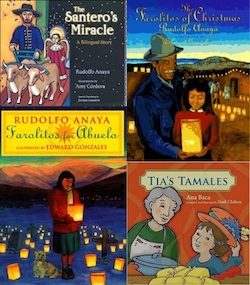by Yoo Kyung Sung, University of New Mexico
 Land of Enchantment! — official nickname of the state I live in: New Mexico. I recall being urged to acquire some kind of “Green Chile literacy” about the culture and history of New Mexico before even packing for Albuquerque. (Green Chile sauce was selected as the best “iconic” American food in 2013). So this week, my focus is on the unheard voices of significance in local literature that helps readers experience and even question cultural omissions and the consequent cultural marginality that results. More importantly, how do we assess how that marginalization in local literature affects readers who identify themselves in books about “my/our place.”
Land of Enchantment! — official nickname of the state I live in: New Mexico. I recall being urged to acquire some kind of “Green Chile literacy” about the culture and history of New Mexico before even packing for Albuquerque. (Green Chile sauce was selected as the best “iconic” American food in 2013). So this week, my focus is on the unheard voices of significance in local literature that helps readers experience and even question cultural omissions and the consequent cultural marginality that results. More importantly, how do we assess how that marginalization in local literature affects readers who identify themselves in books about “my/our place.”
A few years ago, I studied a collection of picture books written about different Korean and Korean-American groups and concluded that there were major issues in both overrepresentation and underrepresentation in the cultural portrayals. One of the findings of the study was that a majority of the books focused primarily on the traditional and historical aspects of Korean culture. The contemporary side of Korean culture was significantly underrepresented. Readers missed depictions of contemporary Korean children prior to immigrating to the U.S. as well as similar reflections about the diversity of present day Korean society. The cultural transformations as well as other evolutionary changes representing current thought, beliefs, and practices were not sufficiently pictured in the books I studied when compared with literature delineating traditional and historical Korean perspectives.
Back then I thought such representational imbalance emanated from the minority status Korean culture has in the publishing industry of the United States. Accordingly, it was hard for my students to empathize with the dynamics of the Korean diaspora when they were truly, and understandably, hesitant cultural outsiders. Living in New Mexico and reading the local literature for several years has pushed me to revise those earlier conclusions. It also precipitated new strategies for me to use to enable my students to become more critical readers. In relation to the rest of the United States, New Mexico is one of the most heavily romanticized states. Consequently, the majority of children’s books about New Mexico are highly focused on celebrative and traditional culture. Food and fiesta still occupy loud voices in the representation of New Mexican culture, state identity, and pride.
For two consecutive semesters, two teams of teacher candidates assembled textsets organized around New Mexican culture. They prioritized books by native New Mexican authors as they narrowed down the books in those sets to a practical size. Without my intended guidance, they discovered issues of representational “fairness.” One of the textset creators reflected:
“After exploring my topic through multiple books, I have concluded that New Mexico authors and books show New Mexico in a very traditional manner. Most of the books from my text set included legends from New Mexico, traditional food from New Mexico, and Christian ideals. The books I found seemed to make New Mexico seem very traditional and exotic. I did not find many books that just explained New Mexico as a normal place. They all included traditional aspects. “
I assume her “normal place” indicated a universal normality about contemporary life without biscozitos and shining luminaria in stories. It was powerful for me when students started noticing what was left unsaid in the books that were purported to be representative stories of “their place.” Another experience my teacher candidates explored in their critical reading was the question of literary cultural marginality. They did conclude that the literature, despite how New Mexico represents itself nationally, does provide only a marginally accurate narrative of a rich and wonderful diverse culture of Native Americans, Hispanics, and Mestizos. While indigenous cultures and communities importantly define the nature of New Mexico, the students noticed a majority of texts represent mainly “Spanish-Hispanic-American” cultures—a heritage deriving from the Spanish colonial period and the strong influence of Mexican culture. Spanish heritage is part of the “public heritage” (Meyers, 2009, p. 415) that makes New Mexico “unique and distinctive.” Unlike the public heritage claim of a truly blended culture, significant differences exist in the power exercised within this cultural blend. New Mexican cultural icons such as luminaria, El cucuy, Winona, flamenco, tortilla, bizcochitos function as metonyms of social significance in New Mexican cultural heritage in children’s books.
Local literature helps readers to strengthen their agency as they question, argue, and discuss the places and unheard voices they know in “their place.” My experience with New Mexican literature opened a door allowing me to engage different readers in thinking about unheard voices while moving them to become critical readers of that literature.
Please visit wowlit.org to browse or search our growing database of books, to read one of our two on-line journals, or to learn more about our mission.
- Themes: Yoo Kyung Sung
- Descriptors: Debates & Trends, Student Connections, WOW Currents
